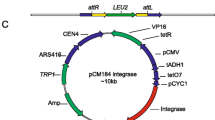Abstract
The genus Habenivirus which includes Ralstonia virus ϕRSM encodes a site-specific integrase of a small serine recombinase belonging to the resolvase/invertase family. Here we describe the integrative/excisive recombination reactions mediated by ϕRSM integrase using in vitro assays. The products of attP/attB recombination, i.e. attL and attR, were exactly identical to those found in the prophage ϕRSM in R. solanacearum strains. The minimum size of attB required for integration was determined to be 37 bp, containing a 13 bp core and flanking sequences of 4 bp on the left and 20 bp on the right. ϕRSM integrative recombination proceeds efficiently in vitro in the absence of additional proteins or high-energy cofactors. Excision of a functional phage genome from a prophage fragment was demonstrated in vitro, demonstrating two-way activity of ϕRSM1 integrase. This is the first example of a small serine recombinase from the resolvase/invertase group that functions in integrative and excisive recombination for filamentous phages. This serine integrase could be used as a tool for several genome engineering applications.



Similar content being viewed by others
References
Askora A, Kawasaki T, Usami S, Fujie M, Yamada T (2009) Host recognition and integration of filamentous phage ϕRSM in the phytopathogen, Ralstonia solanacearum. Virology 384:69–76
Askora A, Kawasaki T, Fujie M, Yamada T (2011) Resolvase-like serine recombinase mediates integration/excision in the bacteriophage ϕRSM. J Biosci Bioeng 111:109–116
Ausubel F, Brent R, Kjngston RE, Moore DD, Seidman JG, Smith JA, Struhl K (1995) Short protocols in molecular biology, 3rd edn. John Wiley and Sons Inc, Hoboken
Bibb LA, Hancox MI, Hatfull GF (2005) Integration and excision by the large serine recombinase ϕRv1 integrase. Mol Microbiol 55:1896–1910
Breüner A, Brøndsted L, Hammer K (2001) Resolvase-like recombination performed by the TP901-1 integrase. Microbiology 147:2051–2063
Fogg PC, Colloms S, Rosser S, Stark M, Smith MC (2014) New applications for phage integrases. J Mol Biol 426:2703–2716
Ghosh O, Wasil LR, Hatfull GF (2006) Control of phage Bxb1 excision by a novel recombination directory factor. PLoS Biol 4(6):e186
Grindley ND, Lauth MR, Wells RG, Wityk RJ, Salvo JJ, Reed RR (1982) Transposon-mediated site-specific recombination: identification of three binding sites for resolvase at the res sites of gamma delta and Tn3. Cell 30:19–27
Grindley NDF, Whiteson KL, Rice PA (2006) Mechanisms of site-specific recombination. Annu Rev Biochem 75:567–605
Groth AC, Calos MP (2004) Phage integrases: biology and applications. J Mol Biol 335(3):667–678
Hatfull GF, Grindley NDF (1988) Resolvases and DNA invertases: a family of enzymes active in site-specific recombination. In: Kucherlapati R, Smith G (eds) Genetic recombination. American Society for Microbiology, Washington, pp 357–396
Hay ID, Lithgow T (2019) Filamentous phages: masters of a microbial sharing economy. EMBO Rep 20(6):e47427
Horita M, Tsuchiya K (2002) Causal agent of bacterial wilt disease Ralstonia solanacearum., p. 5–8. In: National Institute of Agrobiological Sciences (ed.). MAFF microorganism genetic resources manual no. 12 National Institute of Agrobiological Sciences, Tsukuba, Japan
Kawasaki T, Nagata S, Fujiwara A, Satsuma H, Fujie M, Usami S, Yamada T (2007) Genomic characterization of the filamentous integrative bacteriophage ϕRSS1 and ϕRSM1, which infect Ralstonia solanacearum. J Bacteriol 189:5792–5802
Landy A (1989) Dynamic, structural, and regulatory aspects of lambda site specific recombination. Annu Rev Biochem 58:913–949
Merrick CA, Zhao J, Rosser SJ (2018) Serine integrases: advancing synthetic biology. ACS Synth Biol 7:299–310
Mizuuchi K (1997) Polynucleotidyl transfer reactions in site-specific DNA recombination. Genes Cells 2:1–12
Nash HA (1996) Site-specific recombination: integration, excision, resolution and inversion of defined DNA segments. In: Neidhardt FC, CurtissIngraham RJL, Lin ECC, Low KB, Magasanik B, Reznikoff WS, Riley M, Schaechter M, Umbarger HE (eds) Escherichia coli and Salmonella. ASM Press, Washington, pp 2363–2376
Olorunniji FJ, Rosser SJ, Stark WM (2016) Site-specific recombinases: molecular mechanism for the genetic revolution. Biochem J 473:673–684
Rowland SJ, Stark WM, Boocock MR (2002) Sin recombinase from Staphylococcus aureus: synaptic complex architecture and transposon targeting. Mol Microbiol 44:607–619
Sadowski PD (1993) Site-specific genetic recombination: hops, flips, and flops. FASEB J 7:760–767
Sambrook J, Russell DW (2001) Molecular cloning: a laboratory manual. 3rd (ed.). Cold Spring Harbor Laboratory Press, Cold Spring Harbor, New York
Sherratt DJ, Arciszewska LK, Blakely G, Colloms S, Grant K, Leslie N, McCulloch R (1995) Site-specific recombination and circular chromosome segregation. Philos Trans R Soc Lond B Biol Sci 347:37–42
Smith MC, Thorpe HM (2002) Diversity in the serine recombinases. Mol Microbiol 44:299–307
Stark WM, Sherratt DJ, Boocock MR (1989) Site-specific recombination by Tn3 resolvase: topological changes in the forward and reverse reactions. Cell 58:779–790
Stark WM, Boocock MR, Sherrat DJ (1992) Catalysis by site-specific recombinases. Trends Genet 8:432–439
Thorpe HM, Smith MC (1998) In vitro site-specific integration of bacteriophage DNA catalyzed by a recombinase of the resolvase/invertase family. Proc Natl Acad Sci USA 95:5505–5510
Thorpe HM, Wilson SE, Smith MCM (2000) Control of directionality in the site-specific recombination system of the Streptomyces phage phiC31. Mol Microbiol 38:232–241
Wang X, Tang B, Ye Y, Mao Y, Lei X, Zhao G, Ding X (2017) Bxb1 integrase serves as a highly efficient DNA recombinase in rapid metabolite pathway assembly. Acta Biochim Biophys Sin 49:44–50
Zhang L, Ou X, Zhao G, Ding X (2008) Highly efficient in vitro site-specific recombination system based on Streptomyces phage BT1 integrase. J Bacteriol 190:6392–6397
Author information
Authors and Affiliations
Corresponding authors
Ethics declarations
Conflict of interest
The authors declare that they have no conflict of interest.
Ethical approval
This article does not contain any studies with human participants or animals performed by any of the authors.
Additional information
Communicated by Stefan Hohmann.
Publisher's Note
Springer Nature remains neutral with regard to jurisdictional claims in published maps and institutional affiliations.
Supplementary Information
Below is the link to the electronic supplementary material.
Rights and permissions
About this article
Cite this article
Askora, A., Kawasaki, T., Fujie, M. et al. In vitro characterization of the site-specific recombination system based on genus Habenivirus ϕRSM small serine integrase. Mol Genet Genomics 296, 551–559 (2021). https://doi.org/10.1007/s00438-021-01762-5
Received:
Accepted:
Published:
Issue Date:
DOI: https://doi.org/10.1007/s00438-021-01762-5




